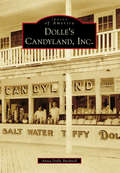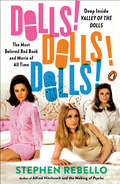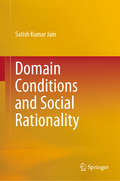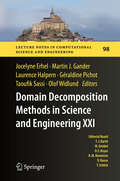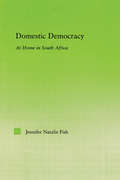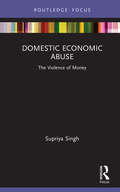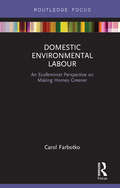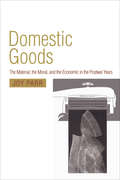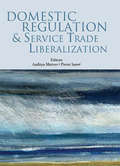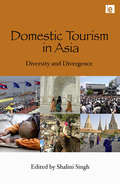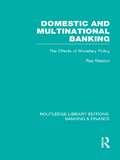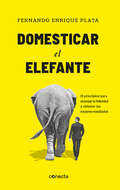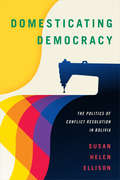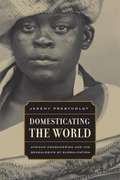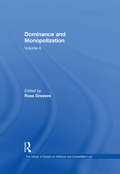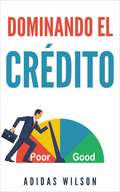- Table View
- List View
Dolle's Candyland, Inc. (Images of America)
by Anna Dolle BushnellDolle's Candyland, Inc., has been an institution to beachgoers of the Eastern Shore since 1910. Behind every piece of saltwater taffy, kernel of caramel popcorn, and other delectable sweet produced by Dolle's is a rich history with ties to other well-known Eastern Shore establishments. Family-owned and -operated since 1910, Dolle's unique history of candy manufacturing makes for an interesting tradition still carried on today. With locations in Ocean City, Maryland, and Rehoboth Beach, Delaware, millions of beachgoers have enjoyed Dolle's by indulging in the homemade sweets or simply enjoying the business's timeless presence on the boardwalks of two popular seashore destinations.
Dolls! Dolls! Dolls!: Deep Inside Valley of the Dolls, the Most Beloved Bad Book and Movie of All Time
by Stephen Rebello"A blissful treasure trove of gossipy insider details that Dolls fans will swiftly devour."--Kirkus ReviewsThe unbelievable-but-true, inside story of Jacqueline Susann's pop culture icon Valley of the Dolls--the landmark novel and publishing phenomenon, the infamous smash hit film ("the best worst movie ever made"), and Dolls's thriving legacy todaySince its publication in 1966, Jacqueline Susann's Valley of the Dolls has reigned as one of the most influential and beloved pieces of commercial fiction. Selling over thirty-one million copies worldwide, it revolutionized overnight the way books got sold, thanks to the tireless and canny self-promoting Susann. It also generated endless speculation about the author's real-life models for its larger-than-life characters. Turned in 1967 into an international box-office sensation and morphing into a much-beloved cult film, its influence endures today in everything from films and TV shows to fashion and cosmetics tributes and tie-ins. Susann's compulsive readable exposé of three female friends finding success in New York City and Hollywood was a scandalous eye-opener for its candid treatment of sex, naked ambition, ageism, and pill-popping, and the big screen version was one of the most-seen and talked-about movies of the time.Dolls! Dolls! Dolls! digs deep into the creation of that hugely successful film--a journey nearly as cut-throat, sexually-charged, tragic, and revelatory as Susann's novel itself--and uncovers how the movie has become a cherished, widely imitated camp classic, thanks to its over-the-top performances, endlessly quotable absurd dialogue, outré costumes and hairdos, despite the high aspirations, money, and talent lavished on it. Screenwriter-journalist-film historian Stephen Rebello has conducted archival research and new interviews to draw back the velvet curtain on the behind-the-scenes intrigue, feuds and machinations that marked the film's production. In doing so, he unveils a rich, detailed history of fast-changing, late 1960s Hollywood, on screen and off.
Domain Conditions and Social Rationality
by Satish Kumar JainThis book primarily focuses on the domain conditions under which a number of important classes of binary social decision rules give rise to rational social preferences. One implication of the Arrow and Gibbard theorems is that every non-oligarchic social decision rule that satisfies the condition of independence of irrelevant alternatives, a requirement crucial for the unambiguity of social choices, and the weak Pareto criterion fails to generate quasi-transitive social preferences for some configurations of individual preferences. The problem is exemplified by the famous voting paradox associated with the majority rule. Thus, in the context of rules that do not give rise to transitive (quasi-transitive) social preferences for every configuration of individual preferences, an important problem is that of formulating Inada-type necessary and sufficient conditions for transitivity (quasi-transitivity). This book formulates conditions for transitivity and quasi-transitivity for several classes of social decision rules, including majority rules, non-minority rules, Pareto-inclusive non-minority rules, and social decision rules that are simple games. It also analyzes in detail the conditions for transitivity and quasi-transitivity under the method of the majority decision, and derives the maximally sufficient conditions for transitivity under the class of neutral and monotonic binary social decision rules and one of its subclasses. The book also presents characterizations of some of the classes of rules for which domain conditions have been derived. The material covered is relevant to anyone interested in studying the structure of voting rules, particularly those interested in social choice theory. Providing the necessary social choice theoretic concepts, definitions, propositions and theorems, the book is essentially self-contained. The treatment throughout is rigorous, and unlike most of the literature on domain conditions, care is taken regarding the number of individuals in the 'necessity' proofs. As such it is an invaluable resource for students of economics and political science, with takeaways for everyone – from first-year postgraduates to more advanced doctoral students and scholars.
Domain Decomposition Methods in Science and Engineering XXI
by Martin J. Gander Laurence Halpern Jocelyne Erhel Géraldine Pichot Taoufik Sassi Olof WidlundThis volume contains a selection of papers presented at the 21st international conference on domain decomposition methods in science and engineering held in Rennes, France, June 25-29, 2012. Domain decomposition is an active and interdisciplinary research discipline, focusing on the development, analysis and implementation of numerical methods for massively parallel computers. Domain decomposition methods are among the most efficient solvers for large scale applications in science and engineering. They are based on a solid theoretical foundation and shown to be scalable for many important applications. Domain decomposition techniques can also naturally take into account multiscale phenomena. This book contains the most recent results in this important field of research, both mathematically and algorithmically and allows the reader to get an overview of this exciting branch of numerical analysis and scientific computing.
Domestic Auto Parts
by Robert S. KaplanDescribes a meeting of an executive team to discuss strategy for a company turnaround. The exercise is to construct a strategy map and Balanced Scorecard to capture the new strategy.
Domestic Democracy: At Home in South Africa (New Approaches in Sociology)
by Jennifer FishFirst published in 2006. Routledge is an imprint of Taylor & Francis, an informa company.
Domestic Economic Abuse: The Violence of Money (Routledge Advances in Sociology)
by Supriya SinghSupriya Singh tells the stories of 12 Anglo-Celtic and Indian women in Australia who survived economic abuse. She describes the lived experience of coercive control underlying economic abuse across cultures. Each story shows how the woman was trapped and lost her freedom because her husband denied her money, appropriated her assets and sabotaged her ability to be in paid work. These stories are about silence, shame and embarrassment that this could happen despite professional and graduate education. Some of the women were the main earners in their household. Women spoke of being afraid, of trying to leave, of losing their sense of self. Many suffered physical and mental ill-health, not knowing what would trigger the violence. Some attempted suicide. None of the women fully realised they were suffering family violence through economic abuse, whilst it was happening to them. The stories of Anglo-Celtic and Indian women show economic abuse is not associated with a specific system of money management and control. It is when the morality of money is betrayed that control becomes coercive. Money as a medium of care then becomes a medium of abuse. The women’s stories demonstrate the importance of talking about money and relationships with future partners, across life stages and with their sons and daughters. The women saw this as an essential step for preventing and lessening economic abuse. A vital read for scholars of domestic abuse and family violence that will also be valuable for sociologists of money.
Domestic Environmental Labour: An Ecofeminist Perspective on Making Homes Greener (Routledge Explorations in Environmental Studies)
by Carol FarbotkoThis book addresses the question of domestic environmental labour from an ecofeminist perspective. A work of cultural geography, it explores the proposition that the practice and politics of domestic labour being undertaken in the name of ‘the environment’ needs to be better recognized, understood and accounted for as a phenomenon shaped by, and shaping of, gender, class and spatial relations. The book argues that a significant yet neglected phenomenon worthy of research attention is the upsurge in voluntary, and yet mostly unrecognized, domestic environmental labour in high-consuming households in late modernity, with the burden often falling on women seeking to green their lives and homes in aid of a sustainable planet. Further, because domestic environmental labour is undervalued in governance and the formal economy, much like other types of domestic labour, householders have become an unrecognized and unaccounted-for supply of labour for the greening of capitalism. Situated within broad global debates on links between ecological and social change, the book has relevance in the many jurisdictions around the world in which households are positioned as sites of environmental protection through green consumption. The volume engages existing interest in household environmental behaviour and practice, advancing understanding of these topics in new ways.
Domestic Goods
by Joy ParrVisions of life in the 1950s often spring from the United States: supermarkets, freeways, huge gleaming cars, bright new appliances, automated households. Historian Joy Parr looks beyond the generalizations about the indulgence of this era to find a specifically Canadian consumer culture. Focusing on the records left by consumer groups and manufacturers, and relying on interviews and letters from many Canadian women who had set up household in the decade after the war, she reveals exactly how and why Canadian homemakers distinguished themselves from the consumer frenzy of their southern neighbours. Domestic Goods focuses primarily on the design, production, promotion, and consumption of furniture and appliances. For Parr, such a focus demands an analysis of the intertwining of the political, economic, and aesthetic. Parr examines how the shortage of appliances in the early postwar years was a direct result of government reconstruction policy, and how the international style of 'high modernism' reflected the postwar dream of free trade. But while manufacturers devised new plans for the consumer, depression-era frugality and a conscious setting of priorities within the family led potential customers to evade and rework what was offered them, eventually influencing the kinds of goods created. This book addresses questions such as, who designed furniture and appliances, and how were these designs arrived at? What was the role of consumer groups in influencing manufacturers and government policy? Why did women prefer their old wringer washers for over a decade after the automatic washer was brought in? In finding the answers the author celebrates and ultimately suggests reclaiming a particularly Canadian way of consuming.
Domestic Military Powers, Law and Human Rights: Calling Out the Armed Forces
by Michael HeadThis book examines the national and international law, human rights and civil liberties issues involved in governments calling out the armed forces to deal with civil unrest or terrorism. The introduction of domestic military powers has become an international trend. Troops already have been seen on the streets in major Western democracies. These developments raise major political, constitutional and related problems. Examining the changes underway in eight comparable countries—the United States, Canada, Britain, France, Italy, Germany, Japan and Australia—this book provides a review and analysis of this trend, including its implications for legal and political rights. The book will be of interest to the general public, as well as students, academics and policy-makers in the areas of human rights and civil liberties, constitutional law, criminal justice and security studies.
Domestic Politics and International Narcotics Control: U.S. Relations with Mexico and Colombia, 1989-2000 (Studies in International Relations)
by Victor J. HinojosaThis book examines different levels of narcotics control cooperation between the United States, Mexico and Colombia. Victor J. Hinojosa finds that Mexico is consistently held to a very different standard than Colombia and that the US often satisfies domestic political pressures to be tough on drugs by punishing Colombia while allowing Mexico much more freedom to pursue different strategies. He also explores the role of domestic terrorism and presidential reputation in Colombia for the US-Colombia pair and the role of competing issues in the US-Mexican bilateral agenda for that country pair, finding that congressional pressure and electoral tests exert the most impact on US behavior but that Mexican and Colombian behavior is best explained in other ways. Together, these findings suggest both the promise of integrating the study of international relations and comparative politics and important limitations of the theoretical framework.
Domestic Public Debt of Externally Indebted Countries
by Manmohan S. Kumar Pablo Emilio GuidottiA report from the International Monetary Fund.
Domestic Regulation and Service Trade Liberalization
by Aaditya Mattoo Pierre SauveTrade in services, far more than trade in goods, is affected by a variety of domestic regulations, ranging from qualification and licensing requirements in professional services to pro-competitive regulation in telecommunications services. Experience shows that the quality of regulation strongly influences the consequences of trade liberalization. WTO members have agreed that a central task in the ongoing services negotiations will be to develop a set of rules to ensure that domestic regulations support rather than impede trade liberalization. Since these rules are bound to have a profound impact on the evolution of policy, particularly in developing countries, it is important that they be conducive to economically rational policy-making. This book addresses two central questions: What impact can international trade rules on services have on the exercise of domestic regulatory sovereignty? And how can services negotiations be harnessed to promote and consolidate domestic policy reform across highly diverse sectors? The book, with contributions from several of the world's leading experts in the field, explores a range of rule-making challenges arising at this policy interface, in areas such as transparency, standards and the adoption of a necessity test for services trade. Contributions also provide an in-depth look at these issues in the key areas of accountancy, energy, finance, health, telecommunications and transportation services.
Domestic Tourism in Asia: Diversity and Divergence
by Shalini SinghMany countries have a rich tradition of domestic travel and holidaying which not only predates but exceeds mass international travel. This is particularly the case in Asia where recent economic prosperity and trends in globalization have not merely spurred, but continue to shape traditions in domestic tourism. This book is the first to address specifically the continuities and changes in domestic tourism in Asia. It explores the ethos of domestic travel and holiday-making in order to understand the distinctive common strands that underlie conventional and contemporary tourism practices, against the local and global backdrop. A considerable range of countries is covered in the case studies, including those with patrimonial histories, namely China and India, the economically developed nation-state of Japan and the microstates of Taiwan, Singapore, Macao and Hong Kong, besides the coastal countries of Malaysia, Philippines, Laos and Vietnam, as well as the land-locked countries of Kyrgyzstan and Mongolia. The book presents some of the many interfaces of Asian cultural and natural heritages with tourism, while giving due considerations to today's political and economic realities.
Domestic and Multinational Banking: The Effects of Monetary Policy (Routledge Library Editions: Banking & Finance)
by Rae WestonThis book examines the fundamental nature of banking in the economy of the 1970s and 80s, arguing that banking cannot be properly understood unless it is regarded as the retailing of financial services. In analysing the nature of banking the book demonstrates how banking might operate without regulatory constraints; surveys the patterns of regulatory constraint in a wide range of economies; analysis the effects of these various forms of constraint on the operation of a previously unregulated bank; examines the move to multinational banking; explores risks peculiar to multinational banking, whilst providing a diagrammatic illustration of those risks. When originally published this was one of the first books to treat banking from both a theoretical and empirical perspective and is unique in reviewing the case of a completely unregulated commercial bank and following the progression of banking through to the multinational stage.
Domesticar al elefante
by Fernando Enrique PlataTodos los seres humanos buscamos la felicidad. Sin embargo, a lo largo de la historia las interpretaciones de lo que significa tener una vida feliz han sido tan diversas como las fórmulas para alcanzarla. Pero lo cierto es que este es un concepto esquivo y esa dificultad para entenderlo nos genera enorme frustración. Fernando Enrique Plata, coach ontológico y conferencista experto en la ciencia de la felicidad, plantea una salida: ser feliz no es una meta, sino una actitud que nos moviliza para conseguir los resultados que deseamos, tanto en nuestra vida personal como en el trabajo. A través de la metáfora del elefante, que representa aquellas narrativas inconscientes que nos impiden cambiar, el autor demuestra que, sin saberlo, nuestro mayor obstáculo somos nosotros mismos. Pero también, que la felicidad es una habilidad que se desarrolla, y en esa medida tenemos el poder de hacernos cargo de nuestro bienestar para transformar la manera en que afrontamos las circunstancias. En eso consiste la domesticación del elefante. La tarea es, entonces, entrenarnos como los mejores cornacas o domadores, y este libro nos enseña cómo. Desde una perspectiva científica y filosófica, que sitúa el lenguaje y el autodescubrimiento como las claves de la transformación, el autor nos entrega 14 principios para una vida feliz, acompañados de herramientas prácticas para ser mejores y actuar en coherencia con los resultados que buscamos. La invitación es a parar y mirar hacia adentro. A desactivar el piloto automático en el que nos sumergen aquellos sesgos y prejuicios paquidérmicos, y a aprender a gestionar nuestras emociones. A que el elefante se vuelva nuestro mejor aliado y que, junto a él, empecemos a transitar el camino hacia la felicidad.
Domesticating Democracy: The Politics of Conflict Resolution in Bolivia
by Susan Helen EllisonIn Domesticating Democracy Susan Helen Ellison examines foreign-funded Alternate Dispute Resolution (ADR) organizations that provide legal aid and conflict resolution to vulnerable citizens in El Alto, Bolivia. Advocates argue that these programs help residents cope with their interpersonal disputes and economic troubles while avoiding an overburdened legal system and cumbersome state bureaucracies. Ellison shows that ADR programs do more than that—they aim to change the ways Bolivians interact with the state and with global capitalism, making them into self-reliant citizens. ADR programs frequently encourage Bolivians to renounce confrontational expressions of discontent, turning away from courtrooms, physical violence, and street protest and coming to the negotiation table. Nevertheless, residents of El Alto find creative ways to take advantage of these micro-level resources while still seeking justice and a democratic system capable of redressing the structural violence and vulnerability that ADR fails to treat.
Domesticating the World: African Consumerism and the Genealogies of Globalization
by Jeremy PrestholdtThis book boldly unsettles the idea of globalization as a recent phenomenon--and one driven solely by Western interests--by offering a compelling new perspective on global interconnectivity in the nineteenth century. Jeremy Prestholdt examines East African consumers' changing desires for material goods from around the world in an era of sweeping social and economic change. Exploring complex webs of local consumer demands that affected patterns of exchange and production as far away as India and the United States, the book challenges presumptions that Africa's global relationships have always been dictated by outsiders. Full of rich and often-surprising vignettes that outline forgotten trajectories of global trade and consumption, it powerfully demonstrates how contemporary globalization is foreshadowed in deep histories of intersecting and reciprocal relationships across vast distances.
Domesticity on Display: Romanian Middle-Class Material Culture from Late Socialism to Today (Consumption and Public Life)
by Maria CristacheThis book examines postsocialist transformations reflected in urban middle-class domestic spaces and in museums dedicated to socialism in Romania. It focuses on the significance and circulation of porcelain and crystal sets and ornaments during late socialism and after 1989, following the experiences of consumers, workers in the glassware and porcelain industry, and artists. By tracing the values and temporalities embedded in materiality, the book sheds light on how objects shape daily life in a time of cultural, economic, and social change. Drawing on ethnographic research, the book offers an in-depth analysis of the ambiguous relation between the middle-class and the socialist state, using materiality and consumption to shed light on contradictions between aspirations and resources and between official discourses and everyday practices. The book reveals changes in practices of display, gift exchange, and barter, in the perception and use of time, as well as in gender and inter-generational relations.This work will be of interest to sociologists, anthropologists and cultural historians, especially researchers interested in consumption, material culture, postsocialism, the anthropology of value and gift, the study of social time, practices of the middle-class, and the history of consumption in Eastern Europe.
Domestique: The Real-life Ups and Downs of a Tour Pro
by Charly Wegelius**Winner - Sweetspot Cycling Book of the Year** For 11 years I was a professional cyclist, competing in the hardest and greatest races on Earth. I was in demand from the world’s best teams, a well-paid elite athlete. But I never won a race. I was the hired help.When my mum dropped me off in a small French town aged 17, I was full of determination to be a professional cyclist, but I was completely green. I went from mowing the team manager’s lawn to winning every amateur race I entered. Then I turned pro and realised I hated the responsibility and pressure of chasing victory. And that’s when I became a domestique.I learned to take that hurt and give it everything I had to give, all for someone else’s win. When the order came in to ride I pushed out with the hardest rhythm I could, dragging the group faster and faster, until my whole body screamed with pain. There were times I rode myself to a standstill, clutching the barrier metres from the line, as the lead group shot past. But that’s what made me a so good at my job.As my career took off, I started looking at the fans lining the route, cheering us like heroes. The passion for cycling oozed off them, but they couldn’t know what it was really like. They didn’t see the terrible hotels, the crazy egos or all the shit that goes with great expectations. Well, this is how it is…
Domina Las Apps: Una Guía para Principiantes para Comenzar a Ganar Dinero con Apps
by Adidas WilsonLas teconlogías de la comunicación avanzan constatemente para adaptarse a los tiempos. Las apps de mensajes son algo enorme ahora. Han superdo completamente a las redes sociales al convertirse en nuestra forma primaria de comunicación. Cuando la mayoría de los empresarios inician, les gusta leer artículos sobre "cómo arrasar con tu primer app," "contruyendo la app de mil millones de dólares" y muchos libros relcionados a este tema. Están pegados a este lado de la historia y cegados al otro. A fin de tener tu propia historia de éxito, debes descubrir por qué otras apps fallan. La dolorosa verdad es que hay más app fallidas que apps exitosas.
Dominance and Monopolization: Volume II (The Library of Essays on Antitrust and Competition Law)
by Rosa GreavesAntitrust and competition law is a fast moving area of law and the subject of extensive academic research. The aim of this volume is to select articles as tools for understanding how antitrust and competition law is applied to unilateral conduct which is harmful to the consumer and to the competitiveness of the market. The articles examine the meaning of dominance and monopolisation and show that although legal and economic rules have been developed to establish whether undertakings hold such strong market positions, it is often difficult to determine with certainty that the undertaking being investigated meets the threshold. The various debates on pricing and non-pricing conduct are also represented as are the conflicts that have arisen regarding the exercise of intellectual property rights by powerful undertakings, particularly in the context of the new economies. The volume includes scholarly articles published on both sides of the Atlantic and enables a greater understanding of the application of antitrust and competition law from the point of view of economics and politics.
Dominando Drones: O Guia Básico para Começar a Ganhar Dinheiro com Drones
by Adidas WilsonEstas informações são a razão pela qual escrevi este livro. De acordo com minhas pesquisas, o ano de 2015 será marcante para os drones. Agora é a hora de empreender para ganhar dinheiro com estes dispositivos. Drones comerciais e seus serviços devem se tornar uma indústria multibilionária na próxima década, de acordo com um novo relatório da empresa de inteligência de mercado Tractica. O relatório diz que, em 2017, a receita de drones deve totalizar US$ 792 milhões - principalmente com vendas de hardware. Até 2025, a Tractica prevê que o mercado aumentará para US$ 12,6 bilhões, com dois terços da receita proveniente de serviços baseados em drones e não de hardware. "Várias indústrias importantes estão vendo futuro na utilização de drones para uso comercial", diz Manoj Sahi, analista de pesquisa da Tractica. Ele citou a mídia, o setor imobiliário e a assistência a desastres como apenas alguns dos setores que poderiam usar serviços habilitados para drones. O relatório afirma que os avanços tecnológicos, as economias de escala, os aplicativos baseados em nuvem e o desejo de romper com o mercado contribuirão para o sucesso comercial dos drones nos próximos anos.
Dominando El Credito
by Adidas WilsonLa sociedad depende en gran medida del crédito para la mayoría de las decisiones financieras. Hoy en día, un buen crédito no solo es importante para obtener un préstamo o una tarjeta de crédito. Muchas compañías tienen que verificar su crédito antes de decidir si extender o no sus productos y servicios. Los prestamistas hipotecarios deben asegurarse de pagar su hipoteca de manera responsable antes de poder financiarla. Sin un buen crédito, el prestamista hipotecario concluye que otorgar un préstamo es arriesgado para ellos.
Dominando Ethereum E Blockchain: Guia Do Iniciante Para Começar A Ganhar Dinheiro
by Adidas WilsonSegundo alguns, a ideia da Ethereum nasceu em 2009, quando a Bitcoin se tornou a primeira solução prática de descentralização. Sem dúvida, o sucesso da Blockchain influenciou bastante Vitalik Buterin, o homem por trás da Ethereum. No entanto, 2012 seria uma data mais específica. Foi quando Vitalik deixou a Universidade de Waterloo para viajar pelo mundo, participando de várias inovações em criptomoedas. Enquanto estava nesta viagem, Buterin concebeu a idéia da Ethereum; uma cripto-plataforma, economicamente segura, para criar qualquer tipo de aplicativo descentralizado. Depois disso, Vitalik começou a redigir o White Paper da Ethereum. O documento justificou a ideia de uma nova cripto-tecnologia , declarou seus princípios capitais e possíveis aplicações. O white paper foi publicado em 2013 e, um mês depois, Buterin anunciou, durante o fórum Bitcointalk, o início do projeto Ethereum . Em seu post, Vitalik disse que estava trabalhando com Jeffrey Wilcke e Dr. Gavin Wood como principais desenvolvedores do postulado central. Wood assumiu o papel principal na criação da Ethereum, depois de Vitalik. Seu Livro Amarelo (a especificação formal da Ethereum Virtual Machine) foi publicado em abril de 2014. Codificando sua primeira implementação prática em sete linguagens de programação, este foi o desenvolvimento do primeiro protótipo da plataforma Ethereum. Assim como a Ethereum, a Bitcoin é baseada na tecnologia Blockchain, mas isso não significa nada, caso não seja apoiada pela rede mais poderosa da história. Os investidores canalizaram milhões de dólares na Bitcoin, usando o dinheiro em comércio, equipamentos de mineração e tecnologias. Lançar uma rede como essa exige a mesma quantidade (ou mais) de esforço. Para iniciar um grupo de investidores, mineradores e desenvolvedores, a fundação Ethereum optou por realizar uma pré-venda de mais de 60 milhões de tokens digitais (Ethers). A campanha acabou sendo um grande sucesso
